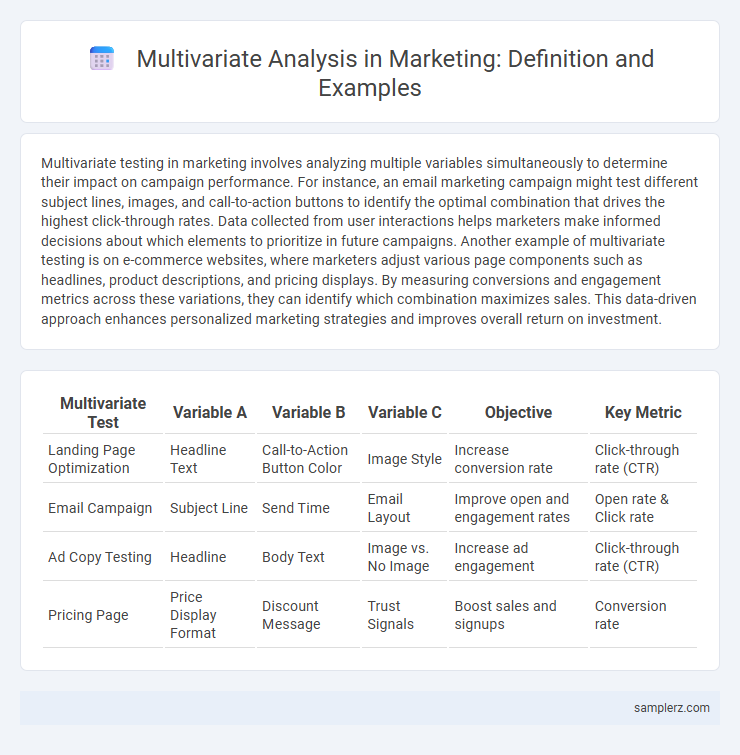Multivariate testing in marketing involves analyzing multiple variables simultaneously to determine their impact on campaign performance. For instance, an email marketing campaign might test different subject lines, images, and call-to-action buttons to identify the optimal combination that drives the highest click-through rates. Data collected from user interactions helps marketers make informed decisions about which elements to prioritize in future campaigns. Another example of multivariate testing is on e-commerce websites, where marketers adjust various page components such as headlines, product descriptions, and pricing displays. By measuring conversions and engagement metrics across these variations, they can identify which combination maximizes sales. This data-driven approach enhances personalized marketing strategies and improves overall return on investment.
Table of Comparison
| Multivariate Test | Variable A | Variable B | Variable C | Objective | Key Metric |
|---|---|---|---|---|---|
| Landing Page Optimization | Headline Text | Call-to-Action Button Color | Image Style | Increase conversion rate | Click-through rate (CTR) |
| Email Campaign | Subject Line | Send Time | Email Layout | Improve open and engagement rates | Open rate & Click rate |
| Ad Copy Testing | Headline | Body Text | Image vs. No Image | Increase ad engagement | Click-through rate (CTR) |
| Pricing Page | Price Display Format | Discount Message | Trust Signals | Boost sales and signups | Conversion rate |
Understanding Multivariate Analysis in Marketing
Multivariate analysis in marketing involves examining multiple variables simultaneously to understand their impact on consumer behavior and campaign effectiveness. For example, analyzing how product price, advertising channel, and customer demographics collectively influence purchase decisions can provide actionable insights. This approach enables marketers to optimize strategies by identifying interactions and key drivers of customer engagement.
Key Benefits of Multivariate Testing for Marketers
Multivariate testing enables marketers to analyze multiple variables simultaneously, identifying the most effective combination of elements such as headlines, images, and calls-to-action to maximize conversion rates. This data-driven approach enhances user experience by tailoring content based on real-time audience interactions, leading to increased engagement and higher ROI. By reducing guesswork, multivariate testing optimizes campaign performance efficiently and drives informed marketing strategies.
Real-World Multivariate Testing Success Stories
Leading e-commerce brands increased conversion rates by 15% through multivariate testing of homepage layouts, product images, and call-to-action buttons, optimizing user engagement based on real-time data. A global retailer boosted average order value by 12% using multivariate analysis on pricing strategies, promotional banners, and checkout processes tailored to segmented customer groups. Software-as-a-Service (SaaS) companies improved trial-to-subscription rates by 20% through multivariate testing of onboarding flows, email sequences, and feature highlights, driving measurable revenue growth.
Multivariate Analysis vs. A/B Testing in Marketing
Multivariate analysis in marketing tests multiple variables simultaneously to identify the best combination of elements influencing consumer behavior, such as headlines, images, and call-to-action buttons. Unlike A/B testing, which compares only two versions, multivariate analysis provides deeper insights by evaluating interactions between variables, optimizing campaigns more efficiently. This method enables marketers to fine-tune complex marketing strategies, improving conversion rates and customer engagement based on data-driven decisions.
Best Practices for Setting Up Multivariate Experiments
Define clear objectives and segment your audience accurately to ensure relevant variable combinations in multivariate marketing experiments. Use robust tracking tools and statistical analysis software to monitor performance metrics like click-through rates, conversion rates, and engagement levels. Test only impactful variables simultaneously to maintain experiment clarity and reduce confounding factors, optimizing resource allocation and data reliability.
Common Variables Used in Marketing Multivariate Tests
In marketing multivariate tests, common variables include headline variations, call-to-action button colors, and page layouts to identify the most effective combination for user engagement. Testing different images, promotional offers, and copy length also helps optimize conversion rates across diverse audience segments. These variables enable marketers to fine-tune campaigns by analyzing interactions between elements and measuring their impact on key performance indicators like click-through and sales rates.
Multivariate Testing for Email Campaign Optimization
Multivariate testing in email campaign optimization involves simultaneously testing multiple variables such as subject lines, call-to-action buttons, and email layouts to identify the most effective combination for increasing open rates and conversions. By analyzing user interactions with different variations, marketers can pinpoint which elements drive engagement and refine their campaigns for higher ROI. This data-driven approach enhances personalization and maximizes the impact of email marketing strategies.
E-Commerce Website Optimization Through Multivariate Analysis
E-commerce websites use multivariate analysis to test different combinations of page elements such as headlines, images, call-to-action buttons, and layouts to identify the highest converting variations. By analyzing user interaction data across these multiple factors simultaneously, marketers optimize website design for improved engagement, reduced bounce rates, and increased sales. This data-driven approach allows precise customization of user experience based on real behavioral insights rather than guesswork.
Multivariate Analysis in Social Media Marketing
Multivariate analysis in social media marketing involves simultaneously examining multiple variables such as post frequency, content type, audience demographics, and engagement metrics to identify patterns that drive campaign success. By analyzing these factors together, marketers can optimize content strategies, increase follower interaction, and boost conversion rates. Platforms like Facebook Insights and Twitter Analytics provide the necessary data for implementing advanced multivariate models to enhance targeting precision and campaign effectiveness.
Future Trends in Multivariate Testing for Marketing
Multivariate testing in marketing is evolving with the integration of artificial intelligence and machine learning, enabling real-time data analysis and personalized customer experiences. Advanced predictive analytics will soon allow marketers to test multiple variables simultaneously across diverse channels, optimizing campaigns with greater precision. Future trends indicate a shift towards automated experimentation platforms that continuously adapt to consumer behavior, enhancing ROI and engagement metrics.

example of multivariate in marketing Infographic
 samplerz.com
samplerz.com